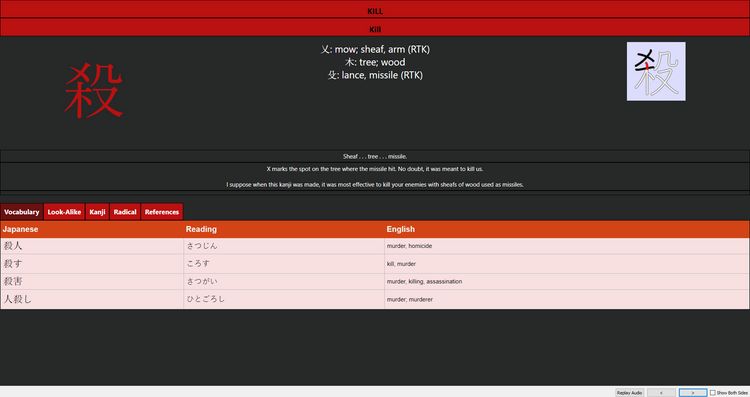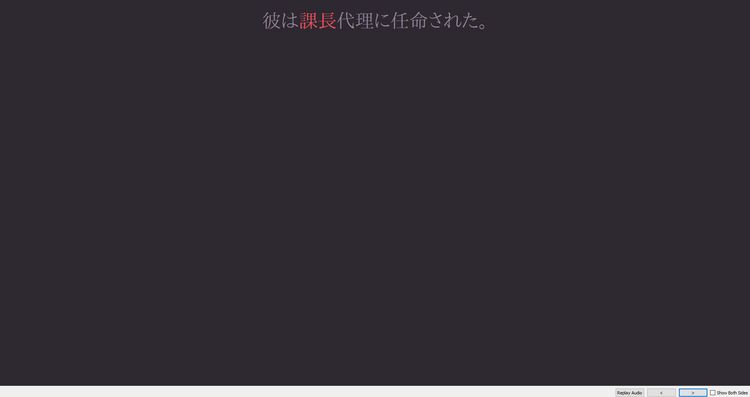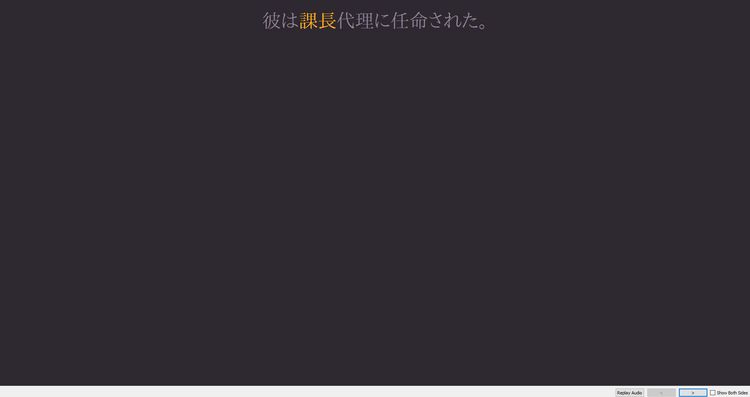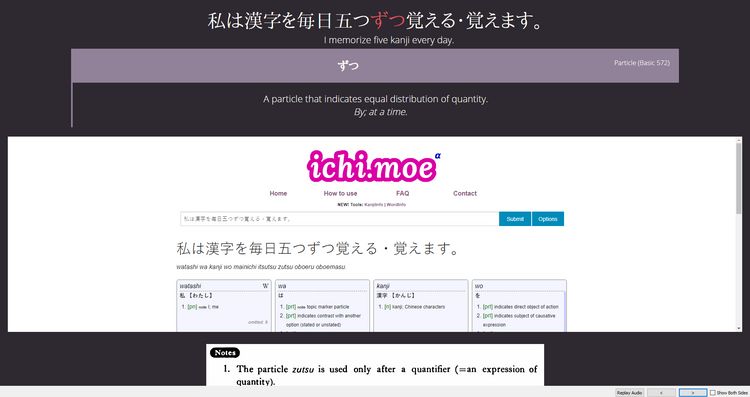I no longer use this Anki setup, and I no longer think it's a good idea. However, I do still think the discussion about what constitutes i+1 is valid and worth having. As for the Anki setup I try to defend in the latter half, consider that as taking i+1 too far.
If you aren't already aware, i+1 is defined as:
If i represents previously acquired linguistic competence and extra-linguistic knowledge, the hypothesis claims that we move from i to i+1 by understanding input that contains i+1. Extra-linguistic knowledge includes our knowledge of the world and of the situation, that is, the context. The +1 represents the next increment' of new knowledge or language structure that will be within the learner's capacity to acquire.
Krashen, S. (2003). Explorations in Language Acquisition and Use. Portsmouth: Heinemann.
This idea is one of the cornerstones of input-based learning. While the above definition is written in typical academic language, in the Japanese learning community (AJATT in particular) it's defined more simply as, "a sentence that contains exactly one unknown word." This definition has worked just fine so far and it has enabled the typical AJATT workflow:
- Immerse in native content.
- When you find a sentence with exactly one unknown word, make a flashcard for it.
Generally, rather than waste time trying to optimize your flashcard setup, it would be recommended to just go immerse more...
Ignoring that advice, let's continue to over-analyze i+1 into oblivion.
A while back I was browsing through Discord and came across an interesting message by neb#5424:
I just find that a lot of people think i + 1 is one extra new vocab, when the "i" should ideally be things you know close to second nature. Those cards are always easy to absorb.. the ones that has half understood grammar, new kanji, vague sentence meanings, those cards are exponentially hard. it's deceptive not i + 1. Anyways, do keep an eye out for them. I wasted a lot of time myself battling those cards.
This idea really stuck out to me, and I think it's truer to the actual definition of i+1 than the typical AJATT definition is. In fact, it also is more true to the traditionally prescribed "patterns" of SRS use.
In the legendary article Augmenting Long-term Memory, Michael Nielsen gives the advice:
Make most Anki questions and answers as atomic as possible: That is, both the question and answer express just one idea. As an example, when I was learning the Unix command line, I entered the question: “How to create a soft link from
linknametofilename?” The answer was: “ln -s filename linkname”. Unfortunately, I routinely got this question wrong.The solution was to refactor the question by breaking it into two pieces. One piece was: “What's the basic command and option to create a Unix soft link?” Answer: “
ln -s …”. And the second piece was: “When creating a Unix soft link, in what order dolinknameandfilenamego?” Answer: “filename linkname”.
If you've spent any amount of time in r/anki you're probably already sick of hearing this advice for the millionth time. However, for whatever reason, this advice hasn't seem to have made it to the Japanese learning community (despite the overwhelming use of Anki).
I believe the reason for this is that people want to either:
- Do as little Anki as possible, or
- Maximize the number of new words learned per day
The consequence of either option is that people end up with cards that aren't even close to i+1. Learning the same amount of information per day with atomic cards would result in vastly more reviews per day. Let's consider what things could represent the 1 in i+1.
- An unknown word (in hiragana or katakana)
- An unknown kanji
- An unknown meaning (of a kanjified word)
- An unknown reading (of a kanjified word)
- An unknown grammar point
If you broke up your cards so that they contained only one instance of anything on that list, it would take an incredible number of cards (as opposed to how most people currently do things). The question is, is it worth it?
I've been experimenting with this idea for close to 2 months now with the following setup:
For learning to recognize kanji, and get an understanding of their meaning, I use Jo-Mako's kanji deck.

I only create cards that use vocabulary from kanji that I've already learned from this deck.
For every sentence, my custom note type will generate 2 cards: one for testing reading, one for testing meaning.

For meaning cards, the target word is highlighted in red.

For reading cards, the target word is highlighted in yellow.

The back looks the same for both.
If you're interested, the highlighting effect is achieved using the following bit of javascript:
<script>
var word = document.getElementById('word');
var sentence = document.getElementById('sentence');
var w = word.innerHTML;
sentence.innerHTML = sentence.innerHTML.replace(w, '<span class="highlightReading">' + w + '</span>');
</script>The sentence itself doesn't necessarily have to be i+1 since I'm not testing myself on the sentence (although I do listen to the full sentence audio on the back of every card). For a bit of justification of this kind of card (as opposed to a regular sentence card), see animecards.site
Finally, I learn grammar points from the DoJG deck.

So in total the routine is:
- 10 cards a day for grammar (this only covers 2 grammar points, the rest of the cards are sentence cards that use that grammar point in order to reinforce it)
- 10 cards a day for kanji
- A variable number of reading/meaning cards per day depending on how many I mine (30-40 total on average)
If that sounds like a lot, well, it absolutely is. My reviews are typically 400-500 per day, which takes a total of around 1.5 hours. However before you completely dismiss this sort of approach as insane and/or unsustainable, there are a couple things to consider.
- Yes, this sort of schedule is pretty much ridiculous, but it happens to fit into my schedule right now. I will absolutely have to massively adjust things in the future when I have less time on my hands.
- A huge chuck of my Anki time comes from those 10 grammar cards a day, which is because I'm creating my own grammar deck (which I build during my reviews).
- Most people doing some flavor of AJATT do Recognition RTK (RRTK), which entails doing a kanji deck in isolation before any kind of vocabulary study. By doing kanji study and vocabulary in parallel, I'm massively adding to the time spent per day in Anki.
Therefore, a much more realistic setup would be:
- 20-40 mined cards a day (remember that the total 'words' is half of that since it's 2 cards per note)
- 5 grammar cards per day
Because of the sheer speed of reviewing cards like these (as opposed to regular sentence cards), you can get away with such a high number of new cards per day while keeping your Anki time under an hour.
But enough of me justifying my absurd study habits, let's get back to the actual question this experiment was trying to answer:
Does this lead to better results than traditional sentence cards?
And my answer to that is... sort of?
It's hard to argue with the results of sentence cards, as many people have used them (along side thousands of hours of immersion) to achieve high levels of language mastery. On the other hand, cards in this style have yet to prove themselves to such a high level.
From my 2 months of use (contrasting with about 2 months of sentence cards before that), I've found these cards much more enjoyable to review. This is because they naturally grant a higher retention rate, as well as being way faster to review.
The downside, of course, is that they require twice the number of cards for the same result. So, even though the review time per card is reduced, the total time spent in Anki ends up being about the same.
However, if the review time is the same, and these cards are more enjoyable to review, in my opinion that makes them worth doing (given that they result in the same quality of learning).
The biggest downside to cards of this style is that they don't give as much practice with reading full sentences. That said, that issue is ameliorated by the following points:
- I listen to the full sentence audio on the back of every card.
- I get practice reading full sentences from the grammar cards.
- I immerse.
The question could be raised, rather than this weird new note type, why not just apply these i+1 principles to regular sentence cards?
The answer to this is, you absolutely could. I would even recommend doing it, given that you have the ability to do so. The main reason I don't (aside from enjoying this review process better), is that I don't have a good source to mine true i+1 sentences reliably and quickly. Remember that each of these sentences are manually mined, which takes time. Mining 20 true i+1 cards every day could end up being unrealistic or even become a stressor.
As for where I mine sentences currently? I'll be making another post about that later.
Anyways, I feel like this post has sort of shifted topics from what i+1 really means to me defending my own unorthodox way of studying new words. Regardless, expect similar chaotic brain-dumps from me in the future.
Dec 27, 2020 Edit
It's been awhile since I wrote this but I thought it was important to note that I no longer use the setup I did when I wrote this post initially.
The biggest change I've made (other than just lowering the amount of cards I do in general), is that I no longer have separate cards for reading/meaning. The reason I've made this change is that I believe that so long as you have an intuition for the kanji that make up a word, the meaning is generally pretty obvious. Therefore, if you can't understand the meaning of a word, it's likely that the issue is really just a lack of understanding of the kanji itself.
For this reason, I now just have 1 card per note, in which I test both the meaning and reading.